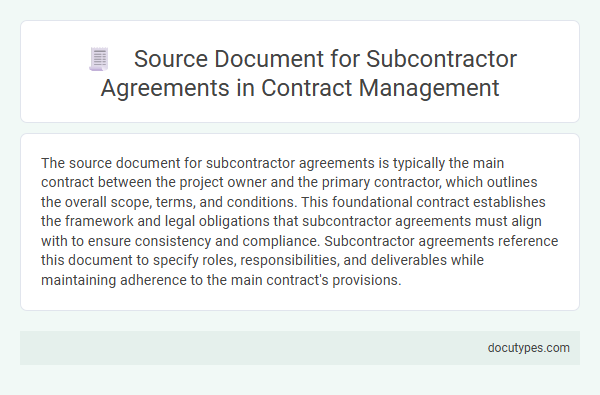The source document for subcontractor agreements is typically the main contract between the project owner and the primary contractor, which outlines the overall scope, terms, and conditions. This foundational contract establishes the framework and legal obligations that subcontractor agreements must align with to ensure consistency and compliance. Subcontractor agreements reference this document to specify roles, responsibilities, and deliverables while maintaining adherence to the main contract's provisions.
Introduction to Source Documents in Subcontractor Agreements
Source documents for subcontractor agreements serve as the foundational records that outline the terms and conditions between a contractor and subcontractor. These documents are essential for ensuring clear communication and legal compliance throughout the project.
You will find that the main source document typically includes detailed scopes of work, payment schedules, and performance requirements. Proper understanding of these documents is crucial for successful subcontractor management and project execution.
Importance of Source Documents in Contract Management
The source document for subcontractor agreements is the original contract or purchase order that outlines the terms and conditions agreed upon by both parties. These documents serve as the foundation for managing subcontractor relationships and ensuring compliance throughout the project lifecycle.
- Foundation for Clear Terms - The source document defines the scope, responsibilities, and payment terms, minimizing disputes and misunderstandings.
- Legal and Compliance Reference - It serves as a critical reference in legal situations and regulatory audits to verify contractual obligations.
- Efficient Contract Management - You rely on source documents to track performance, amendments, and ensure timely execution of subcontractor duties.
Key Components of Subcontractor Source Documents
The source document for subcontractor agreements is the foundational contract that outlines the terms and conditions between the primary contractor and the subcontractor. This document ensures clarity and legal protection for all parties involved.
- Scope of Work - Defines the specific tasks and responsibilities assigned to the subcontractor within the project.
- Payment Terms - Details the payment schedule, rates, and conditions for compensation.
- Legal and Compliance Clauses - Includes provisions for liability, insurance, and adherence to regulatory requirements.
Types of Source Documents in Subcontracting
Source documents for subcontractor agreements are essential records that establish the terms and scope of work in subcontracting relationships. Understanding the types of these documents helps you ensure clarity and legal compliance in your contracts.
- Master Agreement - A primary contract outlining the general terms governing multiple subcontract work orders or tasks.
- Work Orders - Specific documents detailing individual scopes of work, deliverables, and timelines under the master agreement.
- Purchase Orders - Official records authorizing the procurement of goods or services from a subcontractor, serving as binding agreements.
Identifying the correct source document type is vital for managing subcontractor agreements effectively.
Legal Requirements for Subcontractor Agreements
| Source Document for Subcontractor Agreements | |
|---|---|
| Definition | The source document for subcontractor agreements is the primary legal contract that outlines the terms, conditions, obligations, and rights between the main contractor and the subcontractor. This document serves as the basis for all subcontractor activities and financial transactions. |
| Legal Requirements |
|
| Importance | This document ensures that you have a legally binding agreement that protects all parties involved while promoting clarity and reducing risks related to subcontracting relationships. |
Best Practices for Documenting Subcontractor Contracts
What is the source document for subcontractor agreements? The primary source document for subcontractor agreements is the subcontract itself, which outlines the scope of work, payment terms, and responsibilities. Best practices for documenting subcontractor contracts include using clear, detailed language and ensuring all parties review and sign the document to avoid future disputes.
Source Document Validation and Verification Processes
The source document for subcontractor agreements is the original contract or purchase order issued by the primary contractor. Source document validation involves checking the authenticity, completeness, and accuracy of these documents against project specifications and regulatory standards. Verification processes include cross-referencing with subcontractor credentials and approval records to ensure compliance and legitimacy before contract execution.
Common Mistakes in Subcontractor Documentation
The source document for subcontractor agreements is typically the primary contract between the main contractor and the client. This foundational agreement outlines the scope, terms, and obligations that the subcontractor must adhere to.
Common mistakes in subcontractor documentation include unclear terms, incomplete scope descriptions, and lack of detailed payment schedules. These errors can lead to disputes, delays, and potential legal challenges. Ensuring clarity and completeness in all subcontractor documents is essential for smooth project execution and risk management.
Digital Solutions for Managing Source Documents
The source document for subcontractor agreements is typically the original contract or purchase order outlining the agreed terms and scope of work. Digital solutions for managing these source documents include cloud-based contract management systems that enable secure storage, easy retrieval, and version control. Your organization can streamline workflows and enhance compliance by leveraging automated tools designed specifically for subcontractor document tracking.
What Is the Source Document for Subcontractor Agreements? Infographic

